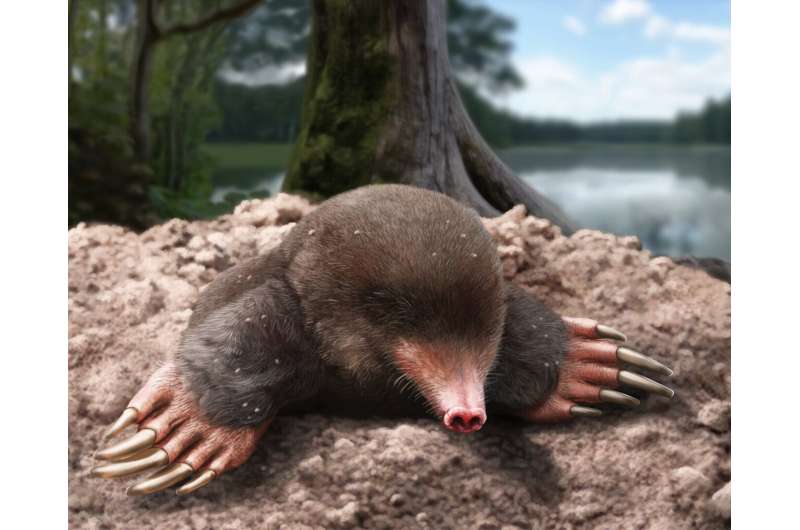Science
Researchers Identify New Mole Species from Ancient Fossil Discovery

A team of researchers has unveiled a new genus and species of mole, named Vulcanoscaptor ninoti, following the discovery of a fossil at the Camp dels Ninots site in Caldes de Malavella, Spain. This previously unknown species dates back to the Pliocene epoch, providing significant insights into the evolutionary history of moles in Europe.
The Camp dels Ninots paleontological site, recognized as one of the most important locations for studying fauna from over 3.5 million years ago, has yielded this remarkable find. The research team comprises experts from the Institut Català de Paleoecologia Humana i Evolució Social (IPHES-CERCA), the Universitat Autònoma de Barcelona (UAB), and the Institut Català de Paleontologia Miquel Crusafont (ICP-CERCA). Their findings have been published in the journal Scientific Reports.
Exceptional Preservation and Insights into Evolution
The fossil, which includes a mandible with complete dentition, parts of the torso, and several anatomical bones, stands out due to its exceptional preservation. This condition is rare among small mammals like moles, making the specimen one of the most complete ever discovered in Europe. According to the study’s lead authors, Adriana Linares and Dr. Marc Furió, this specimen represents the most comprehensive mole fossil known from Pliocene Europe, shedding light on the evolutionary history of the Talpidae family.
Anatomical and phylogenetic analyses indicate that Vulcanoscaptor ninoti belongs to the Scalopini, a tribe of moles currently found only in North America and parts of Asia. This unexpected connection suggests a more intricate evolutionary history than previously assumed. Dr. Furió remarked, “Despite its clearly fossorial morphology, this mole is closely related to extant North American species, pointing to a complex evolutionary history for these animals.”
Advanced Techniques Reveal Unique Features
The fossil was extracted in its entirety from a compact sediment block, allowing for comprehensive analysis without damaging the specimen. Researchers utilized high-resolution micro-computed tomography (microCT) scanning for a detailed three-dimensional reconstruction of the skeleton. Linares explained, “With the microCT, we were able to analyze extremely small structures—such as phalanges and teeth—that would have been nearly impossible to study otherwise.”
The preserved elements include the complete mandible, the right radius, ulna, and humerus, along with various bones of the forelimbs and hindlimbs. This extraordinary preservation provides a unique glimpse into the functional anatomy and ecological adaptations of the mole. The structure of the forelimbs indicates a strong adaptation for digging, yet the conditions of preservation suggest potential aquatic locomotion abilities.
The Camp dels Ninots site has been a focal point for research since 2003. Declared a Cultural Asset of National Interest by the Government of Catalonia in 2015, the site is located within the crater of a Pliocene maar volcano. This geological setting has fostered exceptional preservation conditions, allowing for a rich record of vertebrate remains, including large mammals and various species of flora and fauna.
Dr. Gerard Campeny, co-director of the excavations, emphasized the site’s value: “Camp dels Ninots is extraordinary in both the quality and diversity of its fossil record, enabling us to reconstruct entire ecosystems from the Pliocene.”
The discovery of Vulcanoscaptor ninoti not only confirms the dynamic evolutionary history of moles but also underscores the importance of exceptional fossil sites in documenting species that are rarely preserved in the fossil record. This research highlights the ongoing need for interdisciplinary cooperation in paleontological studies, ensuring that remarkable finds like this continue to enhance our understanding of ancient ecosystems.
-

 Health2 months ago
Health2 months agoNeurologist Warns Excessive Use of Supplements Can Harm Brain
-

 Health2 months ago
Health2 months agoFiona Phillips’ Husband Shares Heartfelt Update on Her Alzheimer’s Journey
-

 Science1 week ago
Science1 week agoBrian Cox Addresses Claims of Alien Probe in 3I/ATLAS Discovery
-

 Science6 days ago
Science6 days agoNASA Investigates Unusual Comet 3I/ATLAS; New Findings Emerge
-

 Science4 days ago
Science4 days agoScientists Examine 3I/ATLAS: Alien Artifact or Cosmic Oddity?
-

 Entertainment3 months ago
Entertainment3 months agoKerry Katona Discusses Future Baby Plans and Brian McFadden’s Wedding
-

 World2 months ago
World2 months agoCole Palmer’s Cryptic Message to Kobbie Mainoo Following Loan Talks
-

 Entertainment3 months ago
Entertainment3 months agoEmmerdale Faces Tension as Dylan and April’s Lives Hang in the Balance
-

 Entertainment3 months ago
Entertainment3 months agoLove Island Star Toni Laite’s Mother Expresses Disappointment Over Coupling Decision
-

 Entertainment2 months ago
Entertainment2 months agoMajor Cast Changes at Coronation Street: Exits and Returns in 2025
-

 World2 months ago
World2 months agoCoronation Street’s Asha Alahan Faces Heartbreaking Assault
-

 Entertainment2 weeks ago
Entertainment2 weeks agoStefan Dennis and Dianne Buswell Share Health Update on Strictly Come Dancing









